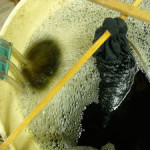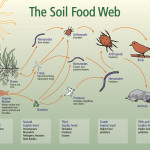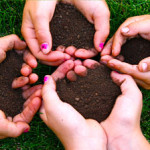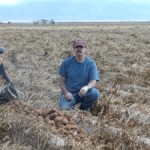Microbiology Is Just A Fancy Word
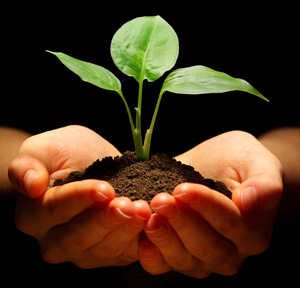 Microbiology is just a fancy word for all those little critters like bacteria and fungi that turn organic materials such as straw and other plant material into compost.
Microbiology is just a fancy word for all those little critters like bacteria and fungi that turn organic materials such as straw and other plant material into compost.
Let's Do It Ourselves
At first we bought compost from a local producer that made good quality compost. After our first purchase, like any successful farmer, we decided we should make it ourselves. After all, each year after we harvest our grain, we bale the residual straw. That straw would provide us 65 percent of the material needed to start our windrows. Now we just needed to find the right equipment for making and monitoring the compost. After endless nights of research and investigation, we ended up going with a company called Midwest Bio-Systems who are in the business of making compost turners. These turners are made to be gentle on the compost assisting us in producing high quality compost.The Advanced Composting System
Midwest Bio-Systems also teaches the Advanced Composting System or “ACS” which stresses the importance of monitoring the O2 in the windrow to keep it at optimum levels to keep the pile aerobic so the good microbiology thrives. This and the heat also helps keeps the anaerobic microbiology out of the windrow making the compost safe for kids, animals and anyone that might handle it. We use a Volumetric CO2 meter with a 36” probe to help us monitor the CO2 and keep the O2 levels from getting too low . We also use a digital thermometer with a 36” probe to check the temperature throughout the pile so we can keep it under 150 degrees F.The Old Fashioned Way
We do not have a meter for monitoring moisture so we do it the old fashioned way and use our hands and feel the compost daily to check the moisture. Not having a meter to check the moisture is actually a great thing in my opinion. Because you have to touch the windrows every day and see what is going on it’s a great way to keeping a hands on approach.Now Add a Dash of Compost Tea
Since composting is the process of getting the microbiology to break down the ingredients over a 8 to 12 week period, it was a no-brainer to start adding our compost tea to the windrows. This adds more microbiology and allows us to get better diversity in our compost. The process of turning bright yellow straw bales into a deep, rich, brown compost is an amazing process that everyone should experience once in their life. Lucky for me and my family we get to be part of that process every day. While it takes nature years, we accomplish this process in a matter of weeks by carefully managing the conditions and keeping the windrows in the optimal state for making compost.My Favorite Part
My favorite part of making compost is reaching into a pile and holding a handful of rich dark earth that smells like the forest floor. While some people think that compost smells bad, quite the opposite is true. You know that compost is ready to apply when you pick it up in your hands and it has a nice earthy smell to it.Related Posts
The following two tabs change content below.


I'm part of a family business that enjoys making high quality compost not just for us but for our customers also. I love taking raw components and turning them into beautiful compost that smells like freshly turned earth. Just knowing how much my compost can help out any soil makes all the hard work worth while.
Latest posts by Justin Rogers (see all)
- The Soil Food Web – Compost Puts the Biology Back Into the Soil - October 22, 2013
- What to Look For in Compost - February 6, 2013
- Microbiology Is Just A Fancy Word - November 19, 2012

